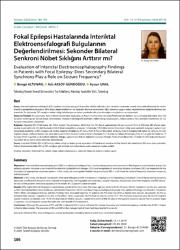| dc.contributor.author | Altunan, Bengü | |
| dc.contributor.author | Gundogdu, Aslı Aksoy | |
| dc.contributor.author | Ünal, Aysun | |
| dc.date.accessioned | 2022-05-11T14:05:04Z | |
| dc.date.available | 2022-05-11T14:05:04Z | |
| dc.date.issued | 2020 | |
| dc.identifier.issn | 1300-7157 | |
| dc.identifier.uri | https://doi.org/10.14744/epilepsi.2020.49140 | |
| dc.identifier.uri | https://hdl.handle.net/20.500.11776/4885 | |
| dc.description.abstract | Objectives: Interictal electroencephalography (EEG) is an electrophysiological test used in daily practice and important in the diagnosis and treatment process for epileptic patients. Accurate assessment of the interictal epileptiform discharges (IEDs) and recognition of secondary bilateral synchrony (SBS) are important for the evaluation of appropriate treatment options. In this study, we investigated whether the presence of SBS is a risk factor for seizure frequency, treatment response, and localization. Methods: In this study, the data of 126 patients who were followed up with the diagnosis of epilepsy in the Neurology Outpatient Clinic of Namk Kemal University Education and Research Hospital were analyzed retrospectively. Demographic characteristics, seizure frequency, localization, treatment response and EEG characteristics of the patients were investigated and the results of 122 patients were obtained. Results: Fifty-eight (46%) of the patients were female, and 68 (54%) were male. The mean age was 36.5 +/- 16.4 (15-78) years. EEG of 15 patients (12.2%) was reported as SBS. Focal epileptiform abnormality was detected in 54 patients (44.2%) and focal irregular background activity (non-epileptic findings) was found in 12 patients (9.8%). When semiological features and EEG findings were evaluated together, 44 patients (34.9%) were classified as frontal lobe seizures, 66 patients (52.4%) as temporal lobe seizures, 16 patients (12.6%) as the others. Forty-six patients (36.5%) had no seizures, while 15 (11.9%) had one seizure per year, 46 (36.5%) had one seizure in one to six months, and 19 (15.1%) had daily or weekly seizures. Twenty-nine (23%) of the 46 seizure-free patients became seizure-free in an early stage, 17 patients (13.5%) became seizure-free after the sixth month of the treatment. Conclusion: Although the presence of IED and SBS in interictal EEG is not a risk factor for seizure frequency and treatment response, and the rate of SBS is higher in frontal lobe seizures. The presence of IED and SBS in the management of treatment may lead to false results. | en_US |
| dc.language.iso | tur | en_US |
| dc.publisher | Kare Publ | en_US |
| dc.identifier.doi | 10.14744/epilepsi.2020.49140 | |
| dc.rights | info:eu-repo/semantics/openAccess | en_US |
| dc.subject | Interictal EEG | en_US |
| dc.subject | seizure frequency | en_US |
| dc.subject | seizure localization | en_US |
| dc.subject | secondary bilateral synchrony | en_US |
| dc.subject | treatment response | en_US |
| dc.subject | Discharges | en_US |
| dc.subject | Eeg | en_US |
| dc.title | Evaluation of Interictal Electroencephalography Findings in Patients with Focal Epilepsy: Does Secondary Bilateral Synchrony Play a Role on Seizure Frequency? | en_US |
| dc.type | article | en_US |
| dc.relation.ispartof | Epilepsi | en_US |
| dc.department | Fakülteler, Tıp Fakültesi, Dahili Tıp Bilimleri Bölümü, Nöroloji Ana Bilim Dalı | en_US |
| dc.identifier.volume | 26 | en_US |
| dc.identifier.issue | 3 | en_US |
| dc.identifier.startpage | 186 | en_US |
| dc.identifier.endpage | 192 | en_US |
| dc.institutionauthor | Altunan, Bengü | |
| dc.institutionauthor | Gundogdu, Aslı Aksoy | |
| dc.institutionauthor | Ünal, Aysun | |
| dc.relation.publicationcategory | Makale - Uluslararası Hakemli Dergi - Kurum Öğretim Elemanı | en_US |
| dc.authorwosid | Gündoğdu, Aslı Aksoy/C-3992-2016 | |
| dc.identifier.wos | WOS:000610799700007 | en_US |



















